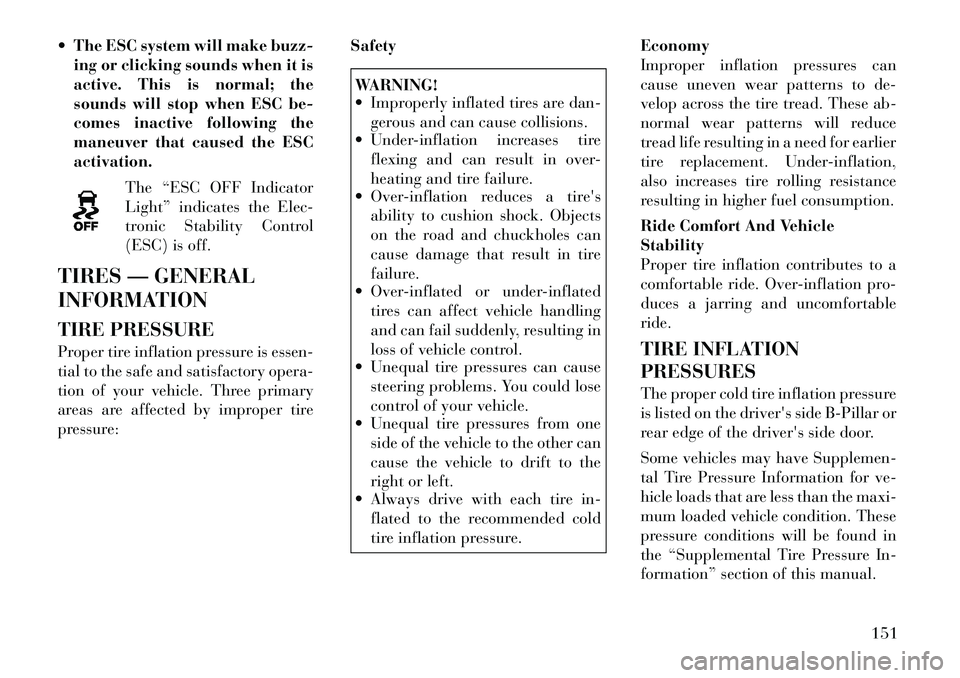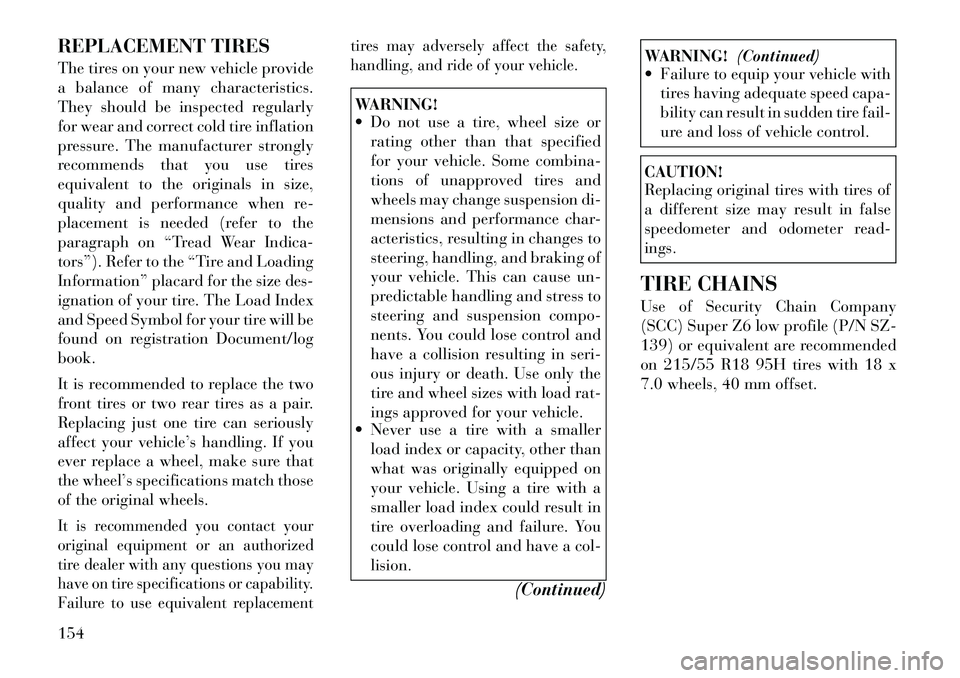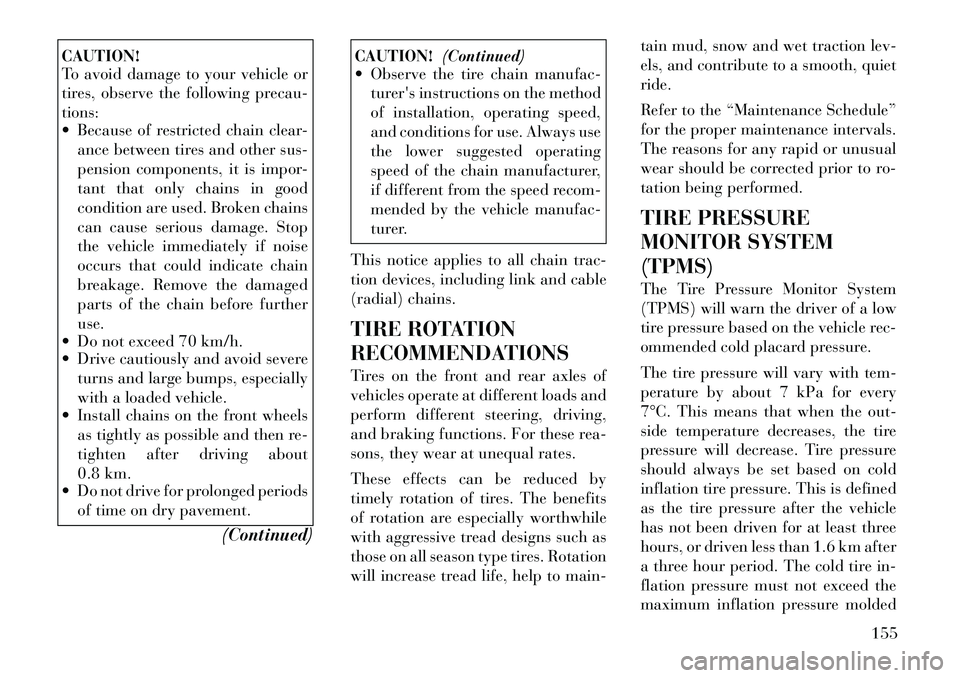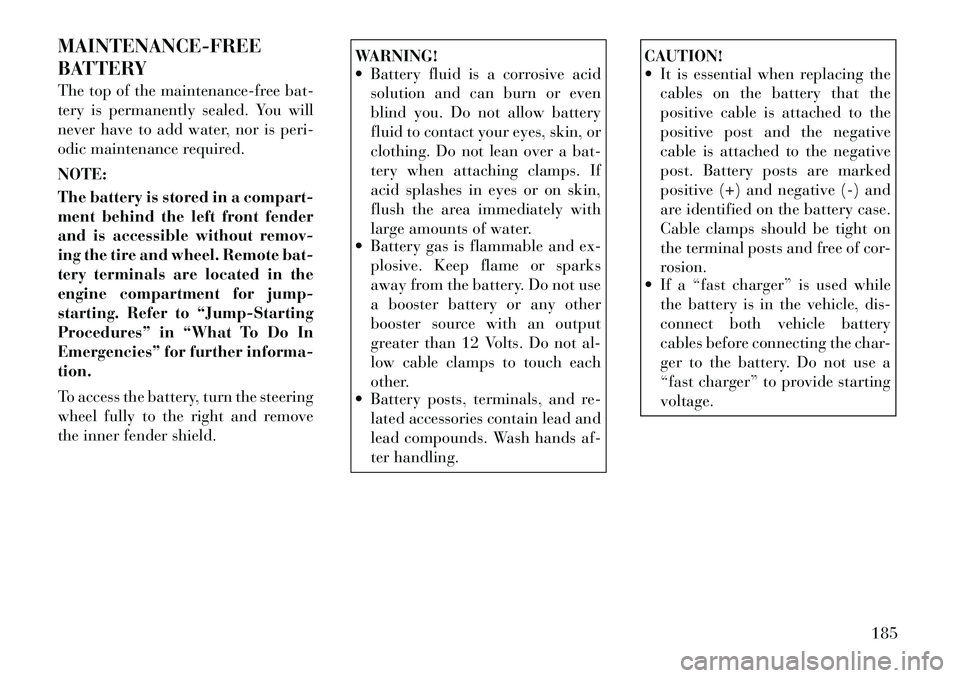steering Lancia Flavia 2012 Owner handbook (in English)
[x] Cancel search | Manufacturer: LANCIA, Model Year: 2012, Model line: Flavia, Model: Lancia Flavia 2012Pages: 233, PDF Size: 2.61 MB
Page 151 of 233

POWER STEERING
The standard power steering system
will give you good vehicle response
and increased ease of maneuverability
in tight spaces. The system will pro-
vide mechanical steering capability if
power assist is lost.
If for some reason the power assist is
interrupted, it will still be possible to
steer your vehicle. Under these condi-
tions, you will observe a substantial
increase in steering effort, especially
at very low vehicle speeds and during
parking maneuvers.
NOTE:
Increased noise levels at the endof the steering wheel travel are
considered normal and do not
indicate that there is a problem
with the power steering system.
Upon initial start-up in cold weather, the power steering
pump may make noise for a
short amount of time. This is due
to the cold, thick fluid in the
steering system. This noise
should be considered normal,
and it does not in any way dam-
age the steering system.
WARNING!
Continued operation with reduced
power steering assist could pose a
safety risk to yourself and others.
Service should be obtained as soon
as possible.CAUTION!
Prolonged operation of the steering
system at the end of the steering
wheel travel will increase the steer-
ing fluid temperature and it should
be avoided when possible. Damage
to the power steering pump may oc-
cur.
POWER STEERING FLUID
CHECK
Checking the power steering fluid
level at a defined service interval is
not required. The fluid should only be
checked if a leak is suspected, abnor-
mal noises are apparent, and/or the
system is not functioning as antici-
pated. Coordinate inspection efforts
through an authorized dealer.
CAUTION!
Do not use chemical flushes in your
power steering system as the chemi-
cals can damage your power steering
components. Such damage is not
covered by the New Vehicle Limited
Warranty.WARNING!
Fluid level should be checked on a
level surface and with the engine off
to prevent injury from moving parts
and to ensure accurate fluid level
reading. Do not overfill. Use only
manufactur er's recommended
power steering fluid.
If necessary, add fluid to restore to the
proper indicated level. With a clean
cloth, wipe any spilled fluid from all
surfaces. Refer to “Fluids, Lubri-
cants, and Genuine Parts” in “Main-
taining Your Vehicle” for further in-
formation.
144
Page 153 of 233

WARNING!(Continued)
Always fully apply the parking
brake when leaving your vehicle
or it may roll and cause damage or
injury. Also, be certain to leave the
transmission in PARK. Failure to
do so may cause the vehicle to roll
and cause damage or injury.CAUTION!
If the “Brake Warning Light” re-
mains on with the parking brake
released, a brake system malfunc-
tion is indicated. Have the brake
system serviced by an authorized
dealer immediately.
ANTI-LOCK BRAKE
SYSTEM (ABS)
The Anti-Lock Brake System (ABS)
provides increased vehicle stability
and brake performance under most
braking conditions. The system oper-
ates with a separate computer to
modulate the hydraulic pressure to
prevent wheel lock-up and avoid
skidding on slippery surfaces.
WARNING!
Pumping of the anti-lock brakes will diminish their effectiveness
and may lead to a collision.
Pumping makes the stopping dis-
tance longer. Just press firmly on
your brake pedal when you need
to slow down or stop.
The ABS cannot prevent the natu-
ral laws of physics from acting on
the vehicle, nor can it increase
braking or steering efficiency be-
yond that afforded by the condi-
tion of the vehicle brakes and tires
or the traction afforded.
The ABS cannot prevent colli-
sions, including those resulting
from excessive speed in turns, fol-
lowing another vehicle too closely,
or hydroplaning.
The capabilities of an ABS-
equipped vehicle must never be
exploited in a reckless or danger-
ous manner, which could jeopar-
dize the user's safety or the safety
of others. The
“Anti-Lock Brake
Warning Light” monitors
the Anti-Lock Brake Sys-
tem. The light will come on
when the ignition switch is turned to
the ON position and may stay on for
as long as four seconds.
If the “Anti-Lock Brake Warning
Light” remains on or comes on while
driving, it indicates that the anti-lock
portion of the brake system is not
functioning and that service is re-
quired. However, the conventional
brake system will continue to operate
normally if the “Brake Warning
Light” is not on.
If the “Anti-Lock Brake Warning
Light” is on, the brake system should
be serviced as soon as possible to re-
store the benefits of anti-lock brakes.
If the “Anti-Lock Brake Warning
Light” does not come on when the
ignition switch is turned to the ON
position, have the bulb repaired as
soon as possible.
If both the “Brake Warning Light”
and the “Anti-Lock Brake Warning
Light” remain on, the Anti-Lock
146
Page 156 of 233

ELECTRONIC STABILITY
CONTROL (ESC)
This system enhances directional con-
trol and stability of the vehicle under
various driving conditions. ESC cor-
rects for over/under steering of the
vehicle by applying the brake of the
appropriate wheel to assist in counter-
acting the over/under steer condition.
Engine power may also be reduced to
help the vehicle maintain the desired
path. ESC uses sensors in the vehicle
to determine the vehicle path in-
tended by the driver and compares it
to the actual path of the vehicle. When
the actual path does not match the
intended path, ESC applies the brake
of the appropriate wheel to assist in
counteracting the oversteer or under-
steer condition.
Over-steer - when the vehicle isturning more than appropriate for
the steering wheel position.
Under-steer - when the vehicle is turning less than appropriate for
the steering wheel position.
WARNING!
The Electronic Stability Control
(ESC) cannot prevent the natural
laws of physics from acting on the
vehicle, nor can it increase the trac-
tion afforded by prevailing road
conditions. ESC cannot prevent ac-
cidents, including those resulting
from excessive speed in turns, driv-
ing on very slippery surfaces, or hy-
droplaning. ESC also cannot pre-
vent accidents resulting from loss of
vehicle control due to inappropriate
driver input for the conditions. Only
a safe, attentive, and skillful driver
can prevent accidents. The capabili-
ties of an ESC equipped vehicle
must never be exploited in a reckless
or dangerous manner which could
jeopardize the user’s safety or the
safety of others. ESC Operating Modes
All ESC equipped vehicles can choose
the following ESC operating modes:
ESC On
This is the normal operating mode for
ESC. Whenever the vehicle is started
the ESC system will be in this mode.
This mode should be used for almost
all driving situations. ESC should
only be turned to “Partial Off” for
specific reasons as noted below.
Partial ESC Mode
This mode is entered by momentarily
pressing the “ESC Off” switch (lo-
cated in the lower switch bank below
the heater/air conditioning controls).
When in “Partial Off” mode, the TCS
portion of ESC, except for the limited
slip feature described in the TCS sec-
tion, has been disabled and the “ESC
Activation/Malfunction Indicator
Light” will be illuminated. All other
stability features of ESC function nor-
mally, with the exception of engine
power reduction. This mode is in-
tended to be used if the vehicle is in
deep snow, sand, or gravel conditions
149
Page 158 of 233

The ESC system will make buzz-ing or clicking sounds when it is
active. This is normal; the
sounds will stop when ESC be-
comes inactive following the
maneuver that caused the ESC
activation.
The “ESC OFF Indicator
Light” indicates the Elec-
tronic Stability Control
(ESC) is off.
TIRES — GENERAL
INFORMATION
TIRE PRESSURE
Proper tire inflation pressure is essen-
tial to the safe and satisfactory opera-
tion of your vehicle. Three primary
areas are affected by improper tire
pressure: Safety
WARNING!
Improperly inflated tires are dan-
gerous and can cause collisions.
Under-inflation increases tire
flexing and can result in over-
heating and tire failure.
Over-inflation reduces a tir e's
ability to cushion shock. Objects
on the road and chuckholes can
cause damage that result in tire
failure.
Over -inflated or under-inflated
tires can affect vehicle handling
and can fail suddenly, resulting in
loss of vehicle control.
Unequal tire pressures can cause
steering problems. You could lose
control of your vehicle.
Unequal tire pressures from one
side of the vehicle to the other can
cause the vehicle to drift to the
right or left.
Always drive with each tire in-
flated to the recommended cold
tire inflation pressure. Economy
Improper inflation pressures can
cause uneven wear patterns to de-
velop across the tire tread. These ab-
normal wear patterns will reduce
tread life resulting in a need for earlier
tire replacement. Under-inflation,
also increases tire rolling resistance
resulting in higher fuel consumption.
Ride Comfort And Vehicle
Stability
Proper tire inflation contributes to a
comfortable ride. Over-inflation pro-
duces a jarring and uncomfortable
ride.
TIRE INFLATION
PRESSURES
The proper cold tire inflation pressure
is listed on the
driver's sideB-Pillar or
rear edge of the driver's side door.
Some vehicles may have Supplemen-
tal Tire Pressure Information for ve-
hicle loads that are less than the maxi-
mum loaded vehicle condition. These
pressure conditions will be found in
the “Supplemental Tire Pressure In-
formation” section of this manual.
151
Page 161 of 233

REPLACEMENT TIRES
The tires on your new vehicle provide
a balance of many characteristics.
They should be inspected regularly
for wear and correct cold tire inflation
pressure. The manufacturer strongly
recommends that you use tires
equivalent to the originals in size,
quality and performance when re-
placement is needed (refer to the
paragraph on “Tread Wear Indica-
tors”). Refer to the “Tire and Loading
Information” placard for the size des-
ignation of your tire. The Load Index
and Speed Symbol for your tire will be
found on registration Document/log
book.
It is recommended to replace the two
front tires or two rear tires as a pair.
Replacing just one tire can seriously
affect your vehicle’s handling. If you
ever replace a wheel, make sure that
the wheel’s specifications match those
of the original wheels.It is recommended you contact your
original equipment or an authorized
tire dealer with any questions you may
have on tire specifications or capability.
Failure to use equivalent replacementtires may adversely affect the safety,
handling, and ride of your vehicle.
WARNING!
Do not use a tire, wheel size or
rating other than that specified
for your vehicle. Some combina-
tions of unapproved tires and
wheels may change suspension di-
mensions and performance char-
acteristics, resulting in changes to
steering, handling, and braking of
your vehicle. This can cause un-
predictable handling and stress to
steering and suspension compo-
nents. You could lose control and
have a collision resulting in seri-
ous injury or death. Use only the
tire and wheel sizes with load rat-
ings approved for your vehicle.
Never use a tire with a smaller
load index or capacity, other than
what was originally equipped on
your vehicle. Using a tire with a
smaller load index could result in
tire overloading and failure. You
could lose control and have a col-
lision.
(Continued)
WARNING!(Continued)
Failure to equip your vehicle with
tires having adequate speed capa-
bility can result in sudden tire fail-
ure and loss of vehicle control.CAUTION!
Replacing original tires with tires of
a different size may result in false
speedometer and odometer read-
ings.
TIRE CHAINS
Use of Security Chain Company
(SCC) Super Z6 low profile (P/N SZ-
139) or equivalent are recommended
on 215/55 R18 95H tires with 18 x
7.0 wheels, 40 mm offset.
154
Page 162 of 233

CAUTION!
To avoid damage to your vehicle or
tires, observe the following precau-
tions:
Because of restricted chain clear-ance between tires and other sus-
pension components, it is impor-
tant that only chains in good
condition are used. Broken chains
can cause serious damage. Stop
the vehicle immediately if noise
occurs that could indicate chain
breakage. Remove the damaged
parts of the chain before further
use.
Do not exceed 70 km/h.
Drive cautiously and avoid severe
turns and large bumps, especially
with a loaded vehicle.
Install chains on the front wheels
as tightly as possible and then re-
tighten after driving about
0.8 km.
Do not drive for prolonged periods
of time on dry pavement.
(Continued)
CAUTION!(Continued)
Observe the tire chain manufac-
tur er's instructions on the method
of installation, operating speed,
and conditions for use. Always use
the lower suggested operating
speed of the chain manufacturer,
if different from the speed r ecom-
mended by the vehicle manufac-
turer.
This notice applies to all chain trac-
tion devices, including link and cable
(radial) chains.
TIRE ROTATION
RECOMMENDATIONS
Tires on the front and rear axles of
vehicles operate at different loads and
perform different steering, driving,
and braking functions. For these rea-
sons, they wear at unequal rates.
These effects can be reduced by
timely rotation of tires. The benefits
of rotation are especially worthwhile
with aggressive tread designs such as
those on all season type tires. Rotation
will increase tread life, help to main- tain mud, snow and wet traction lev-
els, and contribute to a smooth, quiet
ride.
Refer to the “Maintenance Schedule”
for the proper maintenance intervals.
The reasons for any rapid or unusual
wear should be corrected prior to ro-
tation being performed.
TIRE PRESSURE
MONITOR SYSTEM
(TPMS)
The Tire Pressure Monitor System
(TPMS) will warn the driver of a low
tire pressure based on the vehicle rec-
ommended cold placard pressure.
The tire pressure will vary with tem-
perature by about 7 kPa for every
7°C. This means that when the out-
side temperature decreases, the tire
pressure will decrease. Tire pressure
should always be set based on cold
inflation tire pressure. This is defined
as the tire pressure after the vehicle
has not been driven for at least three
hours, or driven less than 1.6 km after
a three hour period. The cold tire in-
flation pressure must not exceed the
maximum inflation pressure molded
155
Page 183 of 233

TOWING A DISABLED VEHICLE
Towing ConditionWheels OFF the Ground Automatic Transmissions
Flat Tow NONEIf transmission is operable:
Transmission inNEUTRAL
40 km/hmax speed
24 km maxdistance
Wheel Lift Or Dolly Tow Rear
Front OK
Flatbed ALLBEST METHOD
Proper towing or lifting equipment is
required to prevent damage to your
vehicle. Use only tow bars and other
equipment designed for the purpose,
following equipment manufacturer’s
instructions. Use of safety chains is
mandatory. Attach a tow bar or other
towing device to main structural
members of the vehicle, not to bum-
pers or associated brackets. State and
local laws applying to vehicles under
tow must be observed.
If you must use the accessories (wip-
ers, defrosters, etc.) while being
towed, the ignition must be in the
ON/RUN position, not the ACC posi-
tion.
CAUTION!
Do not use sling type equipment when towing. Damage to the fas-
cia will occur.
When securing the vehicle to a
flatbed truck, do not attach to
front or rear suspension compo-
nents. Damage to your vehicle
may result from improper towing.
Do not push or tow this vehicle
with another vehicle as damage to
the bumper fascia and transmis-
sion may result.
If the vehicle being towed requires
steering, the ignition switch must
be in the ON position, not the
LOCK or ACC positions. AUTOMATIC
TRANSMISSION
The manufacturer recommends tow-
ing your vehicle with all four wheels
OFF the ground using a flatbed.
If flatbed equipment is not available,
and the transmission is operable, the
vehicle may be flat towed (with all
four wheels on the ground) under the
following conditions:
The shift lever must be in NEU-
TRAL.
The towing distance must not ex- ceed 24 km.
The towing speed must not exceed 40 km/h.
176
Page 188 of 233

ENGINE COMPARTMENT — 2.4L1 — Engine Coolant Reservoir6 — Air Cleaner Filter
2 — Power Steering Fluid Reservoir 7 — Engine Oil Fill
3 — Brake Fluid Reservoir 8 — Coolant Pressure Cap
4 — Power Distribution Center (Fuses) 9 — Engine Oil Dipstick
5 — Integrated Power Module (Fuses) 10 — Washer Fluid Reservoir
181
Page 190 of 233

CAUTION!(Continued)
Car maintenance should be done
at a LANCIA Dealership. For rou-
tine and minor maintenance op-
erations you wish to carry out
yourself, we do recommend you
have the proper equipment, genu-
ine LANCIA spare parts and the
necessary fluids; do not however
carry out these operations if you
have no experience.
Your vehicle has been built with
improved fluids that protect the
performance and durability of
your vehicle and also allow ex-
tended maintenance intervals. Do
not use chemical flushes in these
components as the chemicals can
damage your engine, transmis-
sion, power steering or air condi-
tioning. Such damage is not cov-
ered by the New Vehicle Limited
Warranty. If a flush is needed be-
cause of component malfunction,
use only the specified fluid for the
flushing procedure. ENGINE OIL
Checking Oil Level
To assure proper engine lubrication of
your
vehicle's engine, the engine oil
must be maintained at the correct
level. The best time to check the en-
gine oil level is about five minutes
after a fully warmed engine is shut off.
Do not check oil level before starting
the engine after it has sat overnight.
Checking engine oil level when the
engine is cold will give you an incor-
rect reading.
Checking the oil while the vehicle is
on level ground and only when the
engine is hot, will improve the accu-
racy of the oil level readings. Maintain
the oil level between the range mark-
ings on the dipstick. Either the range
markings consist of a crosshatch zone
marked SAFE or a crosshatch zone
marked with MIN at the low end of
the range and MAX at the high end of
the range. Adding 1.0 Liter of oil
when the reading is at the low end of
the range marking will raise the oil
level to the high end of the range
marking.
CAUTION!
Do not overfill the engine. Over- filling the engine will cause oil
aeration, which can lead to loss of
oil pressure and an increase in oil
temperature. This could damage
your engine. Also, be sure the oil
fill cap is replaced and tightened
after adding oil.
Car maintenance should be done
at a LANCIA Dealership. For rou-
tine and minor maintenance op-
erations you wish to carry out
yourself, we do recommend you
have the proper equipment, genu-
ine LANCIA spare parts and the
necessary fluids; do not however
carry out these operations if you
have no experience.
Change Engine Oil
Refer to the “Maintenance Schedule”
for the proper maintenance intervals.
Engine Oil Selection
SAE Grade 5W-20 SELENIA K
POWER fully synthetic engine oil that
meets FIAT Qualification 9.55535
API SN, ILSAC GF-5 or equivalent.
183
Page 192 of 233

MAINTENANCE-FREE
BATTERY
The top of the maintenance-free bat-
tery is permanently sealed. You will
never have to add water, nor is peri-
odic maintenance required.
NOTE:
The battery is stored in a compart-
ment behind the left front fender
and is accessible without remov-
ing the tire and wheel. Remote bat-
tery terminals are located in the
engine compartment for jump-
starting. Refer to “Jump-Starting
Procedures” in “What To Do In
Emergencies” for further informa-
tion.
To access the battery, turn the steering
wheel fully to the right and remove
the inner fender shield.
WARNING!
Battery fluid is a corrosive acidsolution and can burn or even
blind you. Do not allow battery
fluid to contact your eyes, skin, or
clothing. Do not lean over a bat-
tery when attaching clamps. If
acid splashes in eyes or on skin,
flush the area immediately with
large amounts of water.
Battery gas is flammable and ex-
plosive. Keep flame or sparks
away from the battery. Do not use
a booster battery or any other
booster source with an output
greater than 12 Volts. Do not al-
low cable clamps to touch each
other.
Battery posts, terminals, and re-
lated accessories contain lead and
lead compounds. Wash hands af-
ter handling.
CAUTION!
It is essential when replacing thecables on the battery that the
positive cable is attached to the
positive post and the negative
cable is attached to the negative
post. Battery posts are marked
positive (+) and negative (-) and
are identified on the battery case.
Cable clamps should be tight on
the terminal posts and free of cor-
rosion.
If a “fast charger” is used while
the battery is in the vehicle, dis-
connect both vehicle battery
cables before connecting the char-
ger to the battery. Do not use a
“fast charger” to provide starting
voltage.
185